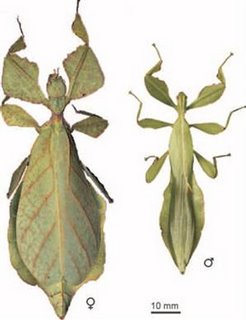Friday, December 29, 2006
The Eocene Epoch: Ancient insects used advanced camouflage
A fossil of a leaf-imitating insect from 47 million years ago bears a striking resemblance to the mimickers of today.
The discovery represents the first fossil of a leaf insect (Eophyllium messelensis), and also shows that leaf imitation is an ancient and successful evolutionary strategy that has been conserved over a relatively long period of time.
Scientists led by Sonja Wedmann of the Institute of Paleontology in Bonn, Germany, unearthed the remains at a well-known fossil site called Messel*, in Hessen, Germany.
The 2.4-inch-long insect had physical characteristics similar to the oblong leaves of trees living there at the time, including Myrtle trees, legumes, such as alfalfa, and Laurel trees.
Continued at "Ancient insects used advanced camouflage" [The Eocene Epoch**] [Image: PNAS]
-------
Based on the Proceedings of the National Academy of Sciences (PNAS) paper:
The first fossil leaf insect: 47 million years of specialized cryptic morphology and behavior
Sonja Wedmann, Sven Bradler, and Jes Rust
Published online before print December 29, 2006, 10.1073/pnas.0606937104
PNAS | January 9, 2007 | vol. 104 | no. 2 | 565-569
Abstract
Stick and leaf insects (insect order Phasmatodea) are represented primarily by twig-imitating slender forms. Only a small percentage (approx 1%) of extant phasmids belong to the leaf insects (Phylliinae), which exhibit an extreme form of morphological and behavioral leaf mimicry. Fossils of phasmid insects are extremely rare worldwide. Here we report the first fossil leaf insect, Eophyllium messelensis gen. et sp. nov., from 47-million-year-old deposits at Messel in Germany. The new specimen, a male, is exquisitely preserved and displays the same foliaceous appearance as extant male leaf insects. Clearly, an advanced form of extant angiosperm leaf mimicry had already evolved early in the Eocene. We infer that this trait was combined with a special behavior, catalepsy or "adaptive stillness," enabling Eophyllium to deceive visually oriented predators. Potential predators reported from the Eocene are birds, early primates, and bats. The combination of primitive and derived characters revealed by Eophyllium allows the determination of its exact phylogenetic position and illuminates the evolution of leaf mimicry for this insect group. It provides direct evidence that Phylliinae originated at least 47 Mya. Eophyllium enlarges the known geographical range of Phylliinae, currently restricted to southeast Asia, which is apparently a relict distribution. This fossil leaf insect bears considerable resemblance to extant individuals in size and cryptic morphology, indicating minimal change in 47 million years. This absence of evolutionary change is an outstanding example of morphological and, probably, behavioral stasis.
Also see:
Correction for Wedmann et al., PNAS 104 (2) 565-569.
Published online before print January 19, 2007, 10.1073/pnas.0700092104
PNAS | February 6, 2007 | vol. 104 | no. 6 | 2024
-------
*Info on the Messel Pit Fossil Site:
"...The Messel fossil finds are extraordinary in more ways than one: entire skeletons are preserved perfectly here - birds with their feathers, mammals with skin and hair. They provide evidence of an important period in the evolutionary history of mammals, which were able to develop at a rapid rate after the extinction of the dinosaurs.
The "Messel Propalaeotherium" represents an early European side branch of the horse family tree: they were much smaller than horses today, lived in the rainforest undergrowth and fed on foliage and fruit, as was established from their teeth and stomach contents. The discovery of an anteater was a huge surprise for palaeontologists, since it originally came from South America. The most common mammal finds are the bats, with the seven species that existed in those times occupying various ecological niches.
The Messel Lake also preserved an astonishingly large number of birds, various reptiles such as turtles, crocodiles and snakes, as well as fish, frogs and a diverse insect fauna. There are 60 families of flora, including various plants whose relations thrive today in South-east Asia, Central and South America. Botanical details have been well-preserved too: flowers in which the pollen grains have survived, as well as fruit clusters and individual fruits..."
-------
**Info on The Eocene Epoch:
"The Eocene epoch is part of the Tertiary Period in the Cenozoic Era, and lasted from about 54.8 to 33.7 million years ago (mya). The oldest known fossils of most of the modern orders of mammals appear in a brief period during the Early Eocene and all were small, under 10 kg. Both groups of modern ungulates (Artiodactyla and Perissodactyla) became prevalent mammals at this time, due to a major radiation between Europe and North America."
-------
A recent post on mimicry: "Predator Mimicry: Metalmark Moths Mimic Their Jumping Spider Predators"
Technorati: fossil, leaf, insect, discovery, imitation, ancient, evolutionary, strategy, paleontology, institute, bonn, messil, site, germany, hessen, insects, camouflage, eocene, epoch, pnas, trait, fossils, mimicry, evolution, change, pit, history, mammals, extinction, dinosaurs
Add to: CiteUlike | Connotea | Del.icio.us | Digg | Furl | Newsvine | Reddit | Yahoo
